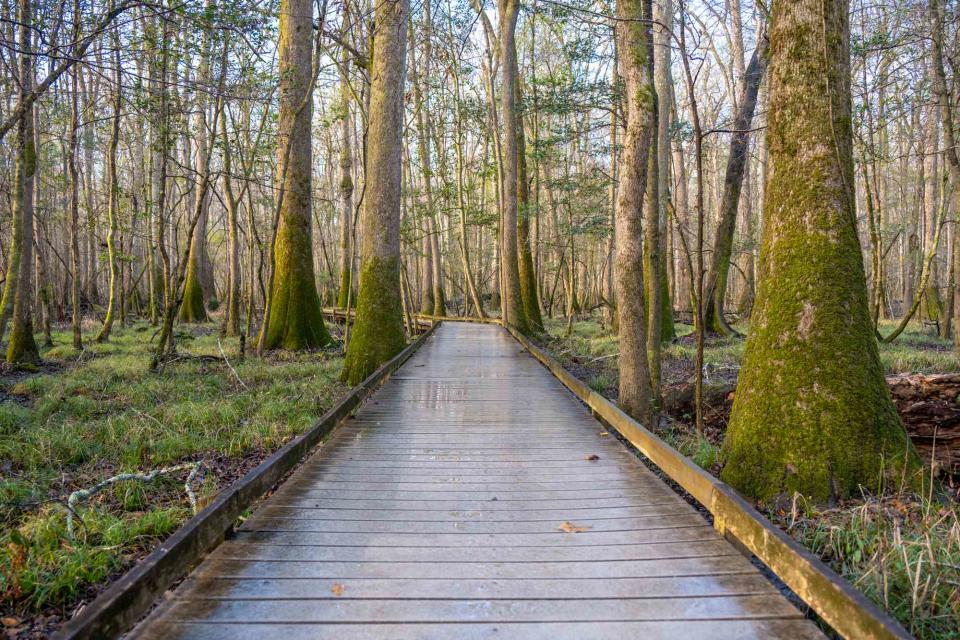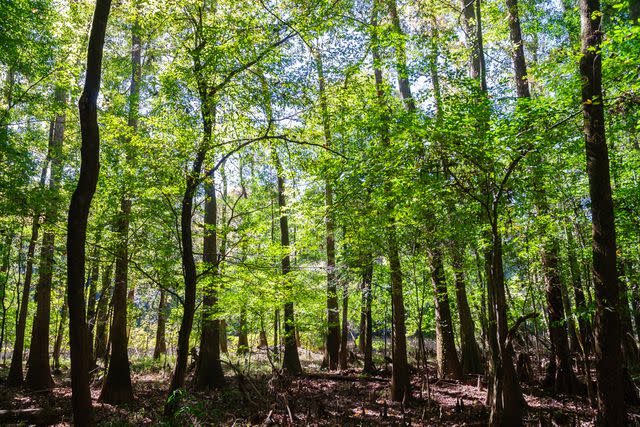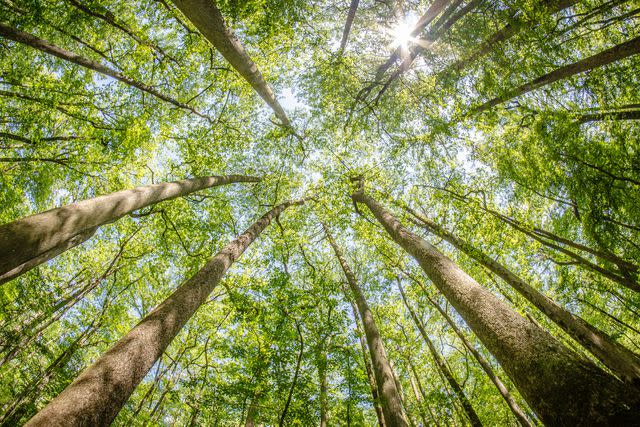This South Carolina National Park Has Waterways Where You Can Float Beneath Some of the Tallest Trees in the U.S. — and an Epic Firefly Spectacle
Here's what you need to know before visiting Congaree National Park.

kellyvandellen/Getty Images
Congaree National Park in South Carolina is known for its astonishing biodiversity — particularly the expanse of old-growth bottomland hardwood forest that is considered to be the largest of its kind in North America. The ancient trees, often called “champion trees” for their age and size, flourish in Congaree National Park’s watery floodplain, which is fueled by the Congaree and Wateree Rivers. The rivers — which border the eastern and southern sides of the park — feed the myriad creeks that crisscross their way around the park, carrying nutrients and sediments that support the ecosystem.
Although the national park contains well over 26,000 acres of relatively untouched backcountry, it is a surprisingly easy 30-minute drive from Columbia, South Carolina, the state’s capital. And while Congaree National Park is best known for its old-growth forest and waterways, it also has excellent hiking that allows visitors to “get lost” in the Congaree wilderness. Fishing and rare synchronous fireflies round out some of the park’s more famous offerings.
Here’s a rundown of what you should know about Congaree National Park before you visit.
Related: The 25 Best National Parks in the U.S.

zrfphoto/Getty Images
Things to Do at Congaree National Park
The park’s waterways, which bring nutrients to the old-growth forest, are also a playground for visitors to Congaree National Park. The Cedar Creek Canoe Trail passes below some of the tallest trees in eastern North America on its 15-mile journey through the wilderness. Experienced paddlers often set their sights on the 50-mile Congaree River Blue Trail, which starts in Columbia and travels downstream through Congaree National Park.
Meanwhile, those looking for a low-key day trip can rent a canoe or kayak from an outfitter in Columbia — or book a guided paddling tour through the park.
For a park that is covered in water, Congaree has a surprising number of trails, many of which run along elevated boardwalks. The Harry Hampton Visitor Center is the trailhead for most routes, and since the park sits in a floodplain, the trails are typically flat. Popular routes include the easy Boardwalk Loop Trail and Kingsnake Trail, which is rated "difficult" and is a favorite among birders.
In the spring, the Firefly Trail is an after-dark favorite, as it leads deep into the forest where a rare species of firefly — the synchronous firefly — puts on a stunning light show during their spring mating season.
Where to Stay
The best way to truly experience the wonders of Congaree National Park is to stay overnight within the park. There are no lodges, but there are two campgrounds that offer basic overnight amenities and night skies filled with stars (and maybe even a firefly or two).
The Longleaf Campground is right next to the park entrance road, making it a seamless home base for overnight visitors. Longleaf is a walk-up campground, meaning campers will need to park in the parking lot and then carry their gear to one of the 10 individual or four group camping sites. There is no water, but water is available 24 hours a day at the nearby Harry Hampton Visitor Center.
Similarly, campers at Bluff Campground will need to either pack in their own water (or refill at the visitor center) and will have to carry their equipment from the car to the campground’s six individual campsites. All campsites must be reserved in advance through Recreation.gov.
Those looking to experience Congaree’s vast, forested wilderness should consider backcountry camping — which involves either a hike or boat ride in. Backcountry camping requires a permit, which is free, but must be requested at least 72 hours in advance via email (sent to cong_information@nps.gov).

digidreamgrafix/Getty Images
How to Get There
For a park that is so wild, Congaree National Park is surprisingly easy to get to. The Harry Hampton Visitor Center is just over 30 minutes by car from the heart of Columbia, under two hours from Charleston, South Carolina, and an hour and a half from Augusta, Georgia.
The Harry Hampton Visitor Center acts as the hub for most of the park’s activities and is a great place to start your journey through Congaree National Park.
When to Visit Congaree National Park
The park is open year round and thanks to South Carolina’s mild winters, many of the trails and waterways remain open in the middle of winter. That said, it’s hard to beat a visit in the spring and fall when the temperatures are warm, but not hot or cold, and there are fewer insects.
Spring, from March to May, is one of the best times to visit the park, especially if you happen to overlap with the annual synchronous firefly mating season (and manage to snag a pass). The event, which occurs two weeks between mid-May and mid-June each year, is marked by thousands of fireflies that light up in unison. The magical spectacle has become so popular, there is now a lottery to get a pass to view the event.
In the fall, from September to November, the temperatures drop from their summertime highs and fall colors begin to arrive. The foliage tends to peak between the end of October and early November, which also happens to be an ideal time to paddle Cedar Creek.
For more Travel & Leisure news, make sure to sign up for our newsletter!
Read the original article on Travel & Leisure.


